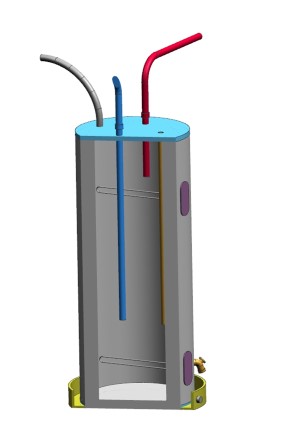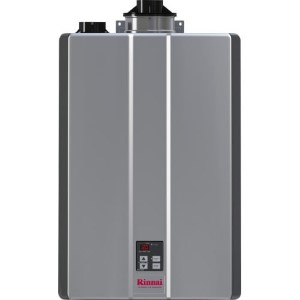- Home
- Electric Water Heaters
- 3 ways to minimize damages
3 Ways to Minimize Damages caused by your Electric Water Heater
 Electric water heater
Electric water heaterFind out how to prevent damages due to electric water heater malfunction. The article guides homeowners through 3 important steps to reduce the risk of potential flooding, heater failure, and property damages. The following tips require basic knowledge and skills of home plumbing and electrical work.
For those who are not comfortable fixing the water heater or dealing with plumbing and electricity, the best choice is to contact a professional plumber or technician. Pros are trained to troubleshoot and repair an HVAC unit or a water heating system per codes, and as requested by the manufacturer, keeping your warranty still valid.
If you would like to know about common problems in electric water heaters, causes, symptoms, and how to troubleshoot them, check out this repair guide. Useful tips are also found in articles about installing an electric water heater and how to maintain it properly.
How to minimize potential property damage from your electric water heater
While electric water heaters are much less complicated than gas heaters, they are still prone to breakages.
How do electric water heaters fail?
Water heaters are designed to heat and deliver water every day. This constant heating and extreme temperature swings create a lot of stress on the elements that will eventually cause problems.
Over time, and due to hard water, mineral deposits will accumulate on the bottom of the tank and its components, corroding all the metal parts.
Water heaters usually fail gradually, showing symptoms such as no or not enough hot water, discolored water, noise, water dripping, breaker tripping, and others.
If the unit stopped operating and delivering hot water, the tank is ruptured, or elements got loose, and there is a danger of water leak, do the following as soon as possible:
|
Compare Quotes from Top-rated Water Heater Experts! Free, No-commitment Estimates. |
Compare Quotes from Top-rated Experts!
Free, No-commitment Estimates.
Turn off the electricity to the heater
 Circuit breakers
Circuit breakersTurning off the electricity is the first thing you should do before trying to repair your electric heater. Most residential electric water heaters use 240 volts, some 120 volts, depending on if there are two heating elements or just one. Dealing with electricity is dangerous (it can kill you), so be very careful.
Find the breaker box. The breaker box is usually located in the laundry (such as mine), garage, or utility room. Open the panel door and find the breaker, usually labeled "AC, furnace, water heater," or something else. Turn it off. Make sure to turn off the right one, so the power to your heater is disconnected.
If there is a switch connected to your water heater, you can also turn it off there.
Before working on any electrical device, always verify if the power is off and if electricity is present on the wires (live wires) that lead to the appliance. Use the multimeter to check or non-contact voltage tester (simpler and safer). It must show no voltage when you touch wires with probes. Sometimes multimeters are also not working, so to be sure, test it first on the outlet in your house that you know is working.
You make electrical wire connections at the top of the water heater at the junction box, enclosed by a cover plate. So remove the cover plate to test, establish, or disconnect the wire connection. This is also the place where you check if the power is off or not.
Once you ensure that the power is off, you can remove an access panel that hides the heating elements and start repairing from there. Again, put one probe of the multimeter on one of the terminals and the other on the water heater tank. Do the same thing for the other terminal. If it reads zero volts, there is no power.
Note: Electric water heaters are designed with heating elements immersed in water. As they get damaged over time, heating elements can short out to the metal tank and electrocute anyone touching the heater or connecting metal elements.
So, if you are not comfortable working on electricity, please contact a local licensed electrician.
Turn off the water supply
 Shut-off valve
Shut-off valveEvery water heater, including your electric type, has two water pipes; cold or incoming pipe, which delivers the cold water to the heater, and hot water or outgoing pipe, which transports hot water to the shower or any other application.
The shut-off valve is usually installed on the cold water line close to the heater. Turn the valve off before repairing the heater.
The most used types of shut-off valves are ball valves with the lever and gate valves with the wheel. If the valve is open, the lever is in line with the pipe. In order to close it, turn it clockwise, so it is perpendicular to the piping.
If you have the gate valve with the wheel installed, turn it clockwise as far as you can until it tightens.
Sometimes it is necessary to shut off the water supply to your home on the main valve. The main water supply valve is usually located in your basement or crawl space (such as mine). This is the best way to stop any leak either from your plumbing, water heater, or any other appliance.
Tip: To prevent damages from a leaky electric water heater, install an automatic shut-off valve. As soon as a water leak is detected, an automatic valve closes the water supply, and the alarm sounds.
Of course, routine maintenance is recommended to keep the efficiency and performance high and prevent any damages to your electric water heater. Deteriorated anode, faulty TPR valve, and sediment buildup are just some of the problems that can structurally damage your water heater.
Drain a water heater
 Drain valve
Drain valveIf you have a problem with your electric water heater, you might need to drain some or all of the water from the tank.
Once the electricity and water supply are off, you can now proceed with draining a water heater.
Locate a drain valve found at the bottom of your electric water heater. It is either plastic or made of brass.
Attach the garden hose to the threaded end of the valve, and run it to the outside or the nearest floor drain.
Open the nearest hot water tap to relieve the pressure built up inside the tank and to drain water quickly. You can also use the TPR valve by lifting the lever.
Open the drain valve and let the tank drain until empty. Be careful; water might still be hot.
Open the cold water to flush the sediments from the tank.
Once the draining is complete, make sure to close the drain valve and TPR valve as well.
If you see a leak on the pipes, put a bucket underneath to collect the water. You can also try to seal a leaking pipe, but this is only a temporary solution.
You can apply the epoxy putty on the leaky pipe, wrap the pipe with the silicon type or rubber gasket, and tighten it with the clamps to seal the leak.
You should flush your water heater at least once a year, but you might want to do it more often if you live in an area with hard water. If the mineral content in your water supply is high, consider either frequent flushing or installing a water softener.
If you don’t flush your water heater regularly, you could see it corrode more quickly or clogging the T&P valve.
Note: During flushing, your electric water heater must be turned off as the heating elements can burn out in a matter of seconds if not submerged into the water.
Other ways to prevent water damages
Homeowners can also take the following steps to minimize the loss due to leaking, but it requires proper planning and more advanced knowledge and skills.
Install a catch pan. Installing a catch pan with a drain should be done before you hook up the heater. The drain pan should be big enough to catch water before rising to the level where it can cause damage.
The automatic shut-off valve is another element that can be added to your existing system or before installing the heater. Once the sensor detects leaks, the valve automatically stops the water flow to the unit.
For the residents who are often at home, water alarms could be useful, as they alert in a case of a leak.
Conclusion
No matter if you are planning to test, fix, replace an element or a heater, or try to prevent any damages due to improper operation of the electric water, use the above tips to deal with the problem safely.
Or, talk to your local plumber if you need professional help.
The guaranteed way to minimize the damage related to your electric water heater is proper installation, per codes and manufacturer’s instructions. Then, regularly inspect components, such as the anode rod, TPR valve, dip tube, thermostats and heating elements, and the storage tank for any visible damages or deformations. As leaks are the most common problem, installing the automatic shut-off valve, catch pans, and drains will definitely save you money and nerves.
Related
- How to repair water heater noise
- What to do when water heater is leaking
- Sediment build-up troubleshooting
- How to fix stinky rotten egg in water heaters
- What to do when water is rusty from the tap
- Water hammer issue and solution
- Milky water - Problem or not
- Plumbing crossover and what to do about it
- 3 ways to minimize damages caused by your electric water heater
Leave a Comment
- Home
- Electric Water Heaters
- 3 ways to minimize damages



